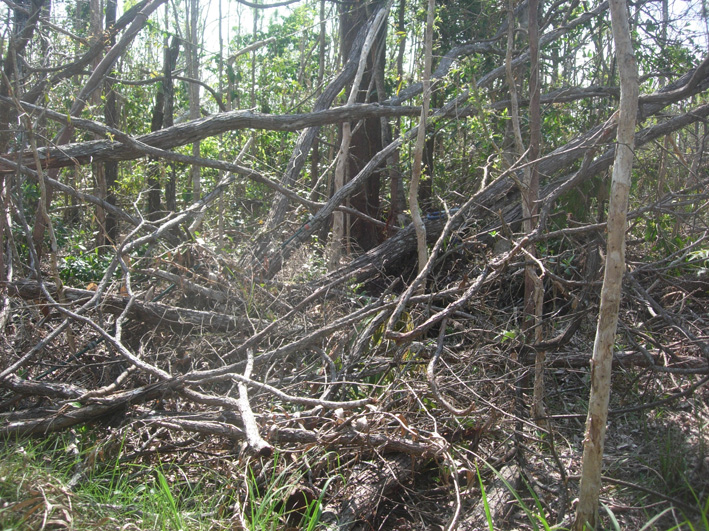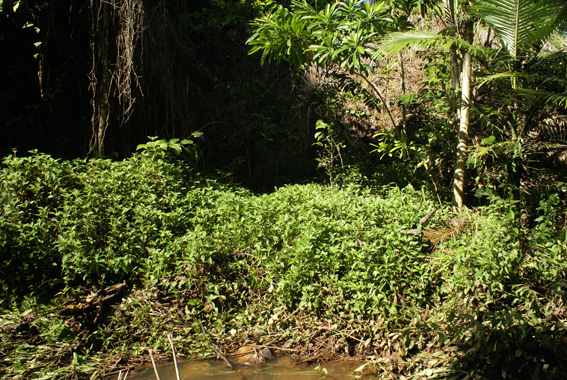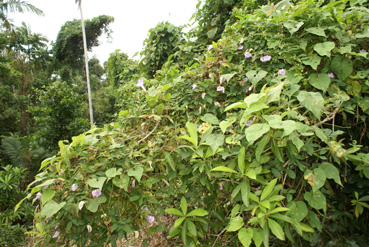| WILDWATCH by ANNE WILKINSON. What an amazing region this is! When one really looks around, how well the forest is recovering after the ravages of Cyclone Yasi. Yes, there are still dead and dying trees, many having fallen and now lodged in others. There are still out-of-reach “hangers” waiting for either wind or natural decay to bring them down necessitating care when walking and the need to remember to look up every now and then to make sure it is safe. From that point of view this is still heartbreak country. |
And she is right. It was hard to recognise it as the same landscape in her pictures. The trees are fluffed out with green, and that triumph of so much rainforest growth, the magnificent bright reds, pinks and orange of new growth, is magnificently evident. Even many of the stumps of trees which had been so badly damaged they were cut down were sprouting leaves and stems which will turn into branches.
Of course it will take many years for the forest to return to what it was, for the trees to grow huge, and it is always possible further cyclones may impede their progress. This is part of the natural cycle in country such as ours which can be subject to extreme weather events.
But the beauty of this wet tropical climate is that even a few years growth can establish itself back into the rhythm and biodiversity which will, if it is not checked, grow into meaningful forest. In fact, even a few months can set it back on its feet again.
| We have been doing a lot of weeding in the Wildwatch forest and yes, when I got home from our friend’s I did have another look at the photographs we had taken after Yasi. I vividly remember panicking after the cyclone and thinking recovery could not be possible – we bought the block for the forest – but natural regeneration is working its magic.There are problems, of course, a major one being the huge, proliferating weeds. |
Included among weeds are also many of the vines which grow fast and have the capacity to eventually bring down trees and even whole sections of forest. Yasi did a great job of spreading such seeds, so to return the forest to a balance many of these smothering vines must go. Often, simply chopping them off at the roots will do the job.
Biodiversity is the lifeblood of the forest. From the tiniest thread of fungi to the tallest tree, everything has its place in the job of supporting the whole.
So don’t burn or chop up all the dead trees – they are part of the forest and necessary to a huge range of small creatures which also play their part in the natural order, as well as eventually rotting down to provide fertilizer for new generations of plants.
And good news is that even in these relatively early days of regeneration we are seeing old favourites like the catbirds and wompoo pigeons. We are serenaded every night by the scrubfowls’ conversations and woken by the bush stone curlews outside the window. Sunbirds and grey whistlers join the various honeyeaters, parrots and currently scrub turkeys, not here for much of the year, are visiting.
There are bandicoots and native mice. The big visiting female cassowary is plump and shiny. The wallabies thrive. And there are butterflies by the dozen.
The old adage, as much as things change, they stay the same, is so true for the forest.
So if you are feeling a bit down and the recovery is not as fast as you would like, get out those old Yasi pictures and see just what nature in the wet tropics can do in a few short months.
| Wildwatch is provided by the Tully branch of the Wildlife Preservation Society of Queensland: enquiries to 4066 5466 or 4066 5650. To contact the emergency 24-hour Wildcare hotline, phone 4068 7272. Phone DERM on 1300 130 372 to report concerns about cassowaries and mahogany gliders. |






